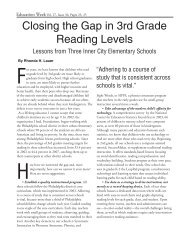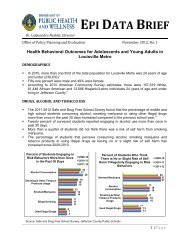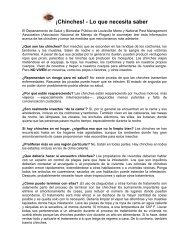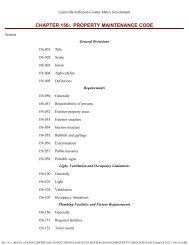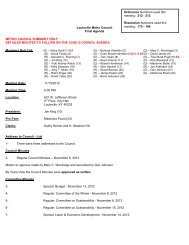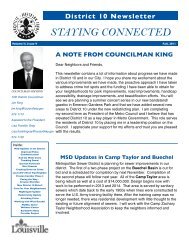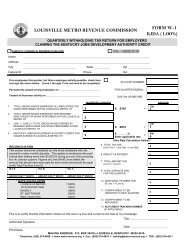Cultural History of Charlie Vettiner Park - Louisville Metro Government
Cultural History of Charlie Vettiner Park - Louisville Metro Government
Cultural History of Charlie Vettiner Park - Louisville Metro Government
Create successful ePaper yourself
Turn your PDF publications into a flip-book with our unique Google optimized e-Paper software.
<strong>Cultural</strong> <strong>History</strong> <strong>of</strong> <strong>Charlie</strong> <strong>Vettiner</strong> <strong>Park</strong><br />
Late Woodland populations included ―sumac, elderberry, raspberry, honey locust, and others‖ in<br />
their diet (Wymer 1992:66).<br />
Mississippian (A.D. 900-1838)<br />
As population densities across North America reached threshold levels and inter- and intravillage<br />
social structures became more complex, a chiefdom-level social system developed. This<br />
social system developed as one village (and one person/group within that village) became more<br />
economically and politically influential among surrounding villages. The Mississippian chiefdom<br />
system coalesced at the confluence <strong>of</strong> the Ohio and Mississippi rivers. Its influence<br />
encompassed vast portions <strong>of</strong> North America, including the Falls <strong>of</strong> the Ohio. Significant<br />
research questions that may be addressed by new data from Jefferson County include the<br />
relationship between Mississippian groups living within the Falls <strong>of</strong> the Ohio area and those at<br />
the Mississippian heartland near present day St. Louis. In addition, the relationship between the<br />
local Mississippian groups and the Fort Ancient groups upstream near present day Cincinnati is<br />
another important avenue <strong>of</strong> research. Perhaps the Falls <strong>of</strong> the Ohio served as a buffer zone<br />
between the two contemporary groups; perhaps the area saw much conflict between the two.<br />
The Mississippian period has been divided into two sub-periods: Early Mississippian (A.D. 900-<br />
1300) and Late Mississippian (1300-1700). The following summarizes data from Lewis (1996).<br />
Artifacts diagnostic <strong>of</strong> the Mississippian culture include new lithic tools such as notched hoes<br />
that exhibit bright polishes from their use in maize agriculture and shell-tempered ceramics that<br />
were made into new forms like jars, saltpans, and hooded bottles. Ceramic decorations<br />
characteristic <strong>of</strong> this period included incising (later) and red filming (earlier).<br />
Settlement patterns typical <strong>of</strong> the Mississippian culture consist <strong>of</strong> fortified villages with<br />
secondary hamlets in the outlying areas (Kreisa 1995). Within the primary village, a platform<br />
mound and plaza area became the center <strong>of</strong> religious and political influence. Structures within<br />
villages reflected social inequality as well as craft specialization. Mississippian houses can be<br />
identified by their rectangular rather than round footprint, trench manufacturing technique, and<br />
wattle-and-daub debris.<br />
Subsistence practices are one <strong>of</strong> the most recognized changes occurring during this time<br />
period. It is not until the Mississippian and Fort Ancient cultures come to rely upon maize as a<br />
major staple that subsistence practices change from hunting, gathering, and horticulture to<br />
agriculture. As mentioned previously, however, maize had been brought into the upper Ohio<br />
Valley earlier. In addition, as Yerkes (1987) emphasizes, subsistence practices from previous<br />
periods continued and some technologies from the previous periods were adapted to the new<br />
practice. Plant knives used with EAC domesticates help make the leap to an agricultural-based<br />
society smoother.<br />
The sudden collapse <strong>of</strong> Mississippian culture is attributed to the introduction <strong>of</strong> European<br />
diseases by the 1500‘s, with much <strong>of</strong> the demise occurring between A.D. 1500 and 1700 (Lewis<br />
1996). Data from the Falls <strong>of</strong> the Ohio region may provide information on whether this demise<br />
happened here concurrently with villages to the west.<br />
As at Otter Creek (Hale 1981), Mississippian houses could be encountered in floodplain settings<br />
near <strong>Charlie</strong> <strong>Vettiner</strong> <strong>Park</strong>. Table 9 summarizes sites with Mississippian components in the<br />
Falls <strong>of</strong> Ohio region.<br />
20 | P a g e



